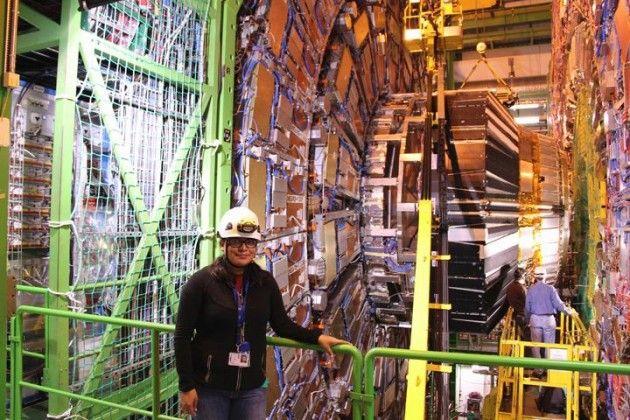The hunt for the Higgs boson is over, and two pioneering physicists now have a Nobel Prize to prove it.
The 2013 Nobel Prize in physics was awarded Tuesday to Peter Higgs and Francois Englert for their prediction, now a half-century old, of the existence of the Higgs boson, a subatomic particle responsible for giving subatomic particles mass. While the prize went to the authors of the theory, thousands of scientists around the world collaborated for several years to find experimental evidence of its existence, a number of whom call Texas A&M home.
“There is a small army of professors, post-docs and graduate students working on [Higgs boson research] here,” said Alexei Safonov, associate professor of physics at Texas A&M and collaborator with the Higgs boson research.
Safonov, the Aggie team and scientists around the world have a conceptually simple job: smash particles together at the speed of light, look at the ensuing sub-atomic chaos and attempt to pick up an idea of how the universe is fundamentally ordered from the pieces. The hard part is in the details.
Bricks and bosons
Texas A&M is a main contributor to the Compact Muon Solenoid, CMS, experiment, one of two general-purpose particle detectors at the Large Hadron Collider, LHC, and a critical source of the data that eventually proved Higgs’ 1960’s theory. The CMS is responsible for tracking and taking data on the storm of subatomic particles that results from the LHC’s work.
Since joining the CMS in 2005, the Texas A&M presence has grown to number about 40 personnel who work on designing the CMS’s components and analyzing the data it streams from Switzerland to College Station.
“[We] helped build the CMS, and we had a full-time Aggie electrical engineer installing it and designing infrastructure,” Safonov said.
Safonov said the CMS is extremely complex due to the minute scales it has to measure. In order to collect accurate data, the detector needs to accurately track the paths of particles significantly smaller than atoms, a feat Safonov described as someone knowing the position of each brick on the facade of the Mitchell Physics building to within millimeters.
Higgs on Higgs
Although the Nobel Prize – and the work by international teams such as the one at Texas A&M that went behind it – give validity to the Higgs boson’s discovery, Safonov is quick to point out that that the real work is just beginning.
“Right now the LHC is undergoing several upgrades,” Safonov said. “We want to turn ourselves into a ‘Higgs factory’ so that we can begin to build the life story of the Higgs boson.”
Complex theory aside, the reality is that while a Higgs event has been verified, no one yet knows whether this was evidence of “the” Higgs boson, or of “a” Higgs boson. To the casual observer the difference is a matter of syntax, but to physicists it is a matter of universal importance.
“Now we are working on confirming Higgs by looking at ways it decays, and checking to see if the Higgs we found is the one predicted by the Standard Model,” Safonov said, referring to the current theory of how subatomic particles and forces interact.
Safonov and the rest of the Texas A&M team are now involved in designing and building the hardware for the LHC’s next generation detectors.
“A large fraction of building the next generation Higgs detectors is taking place here,” Safonov said. “Right now, we’re actually shipping part of the electronics to CERN.”
Jason Giomore, research scientist and member of Texas A&M’s CMS team, said any future discoveries will be made partly through A&M’s current efforts.
“We are contributing to the hardware (of the detectors), and anything discovered in the future will be discovered by our hardware,” Giomore said.
The importance of the miniscule
A&M is not unique in its involvement with the LHC. Thousands of scientists and hundreds of countries participated in the design and construction, and now take part in the scientific discoveries it enables, said Ricardo Eusebi, professor of physics at Texas A&M and member of the CMS team.
Eusebi said it is this scope that makes the LHC and searching for the Higgs boson unique.
“This is the first time that the world comes together to build a machine as complex and as high tech as the LHC and its detectors,” Eusebi said. “It is the biggest scientific endeavor humankind has ever made.”
Small scale, big science
October 11, 2013
Donate to The Battalion
Your donation will support the student journalists of Texas A&M University - College Station. Your contribution will allow us to purchase equipment and cover our annual website hosting costs.




















